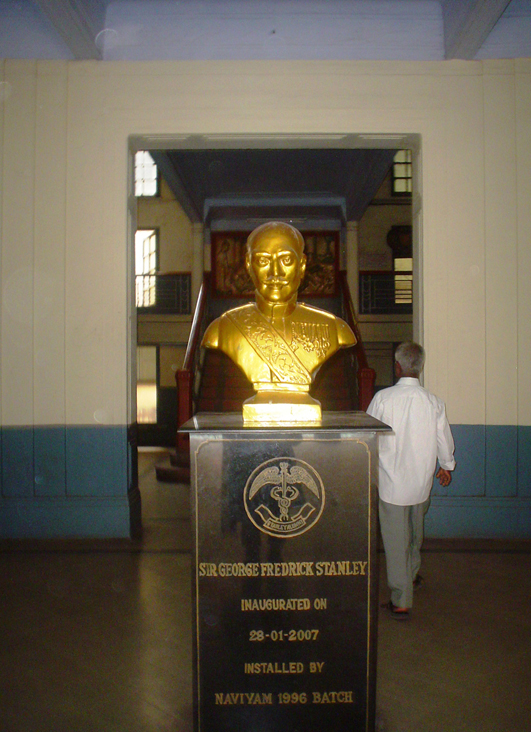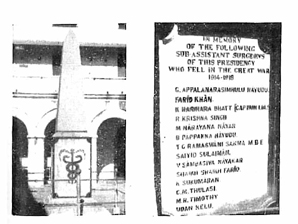|
(Continued from last fortnight)

Sir George Frederick Stanley remembered in Stanley.
|

In memory of those from Stanley who fell in the Great War.
|
Dr. M.K. Srinivasan, a surgeon who passed out in December 1950 from Stanley Medical College, remembers Dr. Viswananthan (VP) and Dr. Kutumbiah (Principal) as exemplary Chiefs who never engaged in private practice. "Dr. Raghavachari was so dedicated that, before exams, he would collect important cases from all wards and hold classes for us from morning 8 to evening 6, providing all refreshments at his personal cost. I was Dr. A.S. Ramakrishnan's assistant for three years and I use over the last 60 years in surgical practice and medical consultation those same principles I learnt then."
On the indomitable 'Stanley Spirit', talk to any Stanleyan and everyone will wax eloquent on the SMC Hostel, the College magazine, NCC and other activities that added considerably to the growth and development of "that unique personality – the Stanley Medico. Students imbibed not only scientific knowledge and technical skill but also the Stanley Spirit of cooperative endeavour, where staff and students moved and worked together as members of a family with affection and mutual respect," says an early note. Dr. A. Ananthanarayanan, former Dean and Director of the Central Institute of Anatomy, SMC, and Dr. S. Balasubramaniam, former Dean, endorse these words.
Dr. G.D. Veliath, former Professor of Pathology, SMC, recalls, "Stanley had a name for the finest histrionic talents. I recall with pleasure the Annual Onam festival, the Bharati Day with its intercollegiate music competition, and Pongal Day celebrations. The inspiration and spirit behind these activities was Dr. C. Raghavachari, who had an inborn love and passion for acting."
Dr. C. Raghavachari, former Professor of Surgery, SMC, notes in the 1963 souvenir, "The coming into existence of the SMC as an upgraded institution in place of the existing medical school with the attached Kanjithotti Hospital may be compared to the transformation of a basic element into a radioactive isotope. Ushered into existence with a legacy and a handicap, this newborn has not only survived but excelled. Rural medical relief work in Almadi and other centres, holding of a World Medical Students' Conference, and the organisation of medical exhibitions to finance the rural medical relief activities are some achievements worth mentioning. These extraordinary achievements of the infant college, which evoked the envy of the sister college, were solely due to the oneness of mind and spirit that prevailed between staff and students. This identity of purpose –this sublime intimacy – came to be referred as the Stanley Spirit. One is filled with a pardonable pride at the thought that he had played some little part in the genesis of that spirit and building of that tradition."
Surgeon Dr. K.C. Nambiar remembers, "The large number of old students, coming out with a subscription of Rs. 1000 per head for the Silver Jubilee, was in itself a sign of the 'Stanley Spirit'. The Old Boys' Association was started here for the first time, and continues to meet periodically. We are the pioneers of the Social Service League in neighbouring villages, financially supported mainly by income from periodic exhibitions conducted by students and staff."
In the pre-Independence era, Stanley Medical College was the hub of passionate nationalism. Students, led by Dr. M. Vishwanathan who was then an undergraduate, hoisted the Indian tricolour in 1942. Dr. Dinkar Rau, the then Principal, ignored the anti-government act of the students as similar incidents were erupting across the country. The British Surgeon General demanded that the tricolour be brought down and, finally, the students themselves removed the flag in deference to their respect for Dr. Rau. In silent protest, they vacated their hostels and marched through the streets of Broadway and chose temporary accommodation outside the hospital.
The opening of the Rural Medical Relief Centre at Alamadi was a pioneering effort that cast a probing light on the problems of providing medical relief in the villages. The College had a well-equipped gym, the only medical college that could boast of one at the time.
Dr. R. Surendran, who retired as Director of the Institute of Surgical Gastroenterology in January 2012 (he did his graduation and postgraduation at SMC), cites Dr. Venkataswami and Dr. Rajashekar Reddy (RJR) as his inspirations. "We never bought textbooks, they were all donated by our seniors who guided us in important exams too. All the top university rankers were from Stanley, which was known for its sports prowess and cultural activities too. Students came mostly from middle class backgrounds or were first gen learners, and so were more close-knit. Our homely hostel canteen was known for its 'Oil Chicken' and attracted students from other colleges too!
"RJR was a wonderful man, with a soft corner for the poor. Our unit every Sunday conducted camps in slums with an NGO, Swallows India. Every admission day, we had Evening Clinics conducted by Assistant Professors who took class from 6 to 9 or even 10! The Unit Chief was like a demi god and even till the 1980s, we remember, his rounds would be like a procession of a temple idol! Among Professors there was a healthy competition to see who taught better. Surgeon Dr. C.S. Ramachandran and cardiologist Dr. Jayanthi Rama Rao of the 1970s, were allrounders who would even sing and dance to inspire us to learn well. 'You can be an idiot, but be a thundering idiot!' RJR would say to us."
The Hospital's Department of Surgical Gastroenterology was the first public sector hospital in India to perform a successful liver transplant under the leadership of Dr. R.P. Shanmugam. In 1999, there began as a pilot project a 20-bed surgical ward to treat liver, pancreatic, and intestinal cases. Patients were ideally expected to pay a lump-sum of Rs. 5,000 to the Tamil Nadu Medical Services Commission, but 50 per cent of the cases (mostly rickshaw-pullers and port labourers with alcohol troubles) were handled free. Currently, the Institute of Surgical Gastroenterology and the Centre for Liver and Pancreatic Diseases at Stanley perform the maximum number of surgeries related to cancer of the pancreas and form the only public sector institutes to successfully perform liver transplants. That first successful liver transplant was in 2009. Since then, the institute with an ISO 9001 certification (acquired in 2000), another first for a public sector hospital in the country, has performed over 35 successful liver transplants.
An ICMR Stem Cell and Diagnostic Laboratory ensures a zero infection rate that is critical for a transplant programme, and is involved in ongoing research on liver progression cells as a therapeutic option in end-stage liver disease. With a medical infrastructure as good as a five-star hospital's, Stanley has been drawing the middle class people who prefer to pay Rs. 5000 instead of Rs. 5 lakh involved in the corporate sector for a hepatectomy (removal of affected liver) or a whipples operation for pancreatic cancer.
Today, most of the old buildings have been replaced by newer structures in order to cater to the needs of larger patient population. A rare surviving bit of heritage in a forgotten corner is an obelisk with the Aesculapius insignia raised in Maj. E.W.C. Bradfield's time to remember 12 doctors who sacrificed their lives in the Great War. What continues unchanged at Stanley are the old traditions of committed service in an institution that today, as in the past, provides affordable healthcare to the underprivileged!
(Concluded)
|